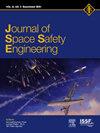Application of Re-entry survivability analysis tool to mars planetary protection
IF 1.7
Q3 ENGINEERING, AEROSPACE
引用次数: 0
Abstract
JAXA develops the Object Re-entry Survival Analysis Tool - Japan (ORSAT-J), which is a tool to assess the survivability and risk to the ground of objects re-entering from low Earth orbit. This tool is derived from NASA's ORSAT ver. 4.
ORSAT-J can calculate the temperature of an entering object during its entry into a celestial body with respect to the elapsed time. Therefore, in terms of planetary protection, it could be used to evaluate whether aerodynamic heating during celestial entry is sufficient for sterilization in the event of an Earth-derived spacecraft entering into a celestial body due to an accidental event. JAXA plans some Martian biosphere exploration missions such as the MMX mission, and is aiming to build a tool that can easily analyse the aerodynamic heating during Mars entry.
In this paper, we collected and evaluated the information such as celestial geometry, gravity model, atmospheric model, radiative heating, etc. necessary to perform a Mars entry heating analysis with ORSAT-J. These were applied to the code and compared with the measured data of Schiaparelli of the ExoMars Program. The novelty of this paper is that it introduces a comprehensive analysis method for Mars entry, including trajectory and heating simulations, into a simplified survivability analysis tool for the on-ground risk of re-entry into Earth.
再入生存能力分析工具在火星行星保护中的应用
JAXA开发了物体再入生存分析工具-日本(ORSAT-J),该工具用于评估从低地球轨道再入的物体的生存能力和对地面的风险。这个工具来自美国宇航局的ORSAT卫星。4.ORSAT-J可以计算进入天体的物体在进入天体期间的温度与经过的时间的关系。因此,在行星保护方面,可以用来评估在地球源航天器因意外事件进入天体时,进入天体时的气动加热是否足以进行灭菌。JAXA计划一些火星生物圈探测任务,如MMX任务,并旨在建立一个工具,可以很容易地分析进入火星时的空气动力学加热。本文利用ORSAT-J收集并评估了进行火星入口加热分析所需的天体几何、重力模型、大气模型、辐射加热等信息。将这些数据应用于代码中,并与ExoMars计划的Schiaparelli测量数据进行了比较。本文的新颖之处在于,将一种综合的火星进入分析方法,包括轨道和加热模拟,引入到一个简化的再入地球地面风险的生存能力分析工具中。
本文章由计算机程序翻译,如有差异,请以英文原文为准。
求助全文
约1分钟内获得全文
求助全文
来源期刊

Journal of Space Safety Engineering
Engineering-Safety, Risk, Reliability and Quality
CiteScore
2.50
自引率
0.00%
发文量
80
 求助内容:
求助内容: 应助结果提醒方式:
应助结果提醒方式:


